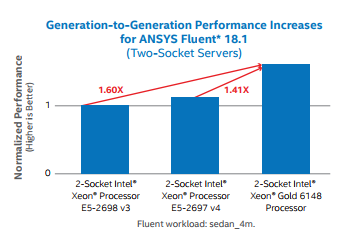ANSYS Fluent* 18.2 Powered by Intel® Xeon® Gold 6148 Processors
Takes Complex Manufacturing Simulation to the Next Level
When it comes to simulation technologies, engineers and designers always want more: more granular detail, more variables, greater accuracy, and faster time to results. Now, thanks to a collaboration between Intel and engineering simulation software provider ANSYS, they’re getting a major leap in performance.
 The Intel® Xeon® Gold 6148 processor – part of the new Intel® Xeon® Scalable processor family – boosts performance for ANSYS Fluent* 18.1 by up to 41 percent versus a previous-generation processor; and, it provides up to 34 percent higher performance per core,1 which helps contain licensing costs.
The Intel® Xeon® Gold 6148 processor – part of the new Intel® Xeon® Scalable processor family – boosts performance for ANSYS Fluent* 18.1 by up to 41 percent versus a previous-generation processor; and, it provides up to 34 percent higher performance per core,1 which helps contain licensing costs.
“ANSYS teamed with Intel to make sure software and hardware improvements go hand in hand,” said Dr. Wim Slagter, Director of HPC and Cloud Alliances for ANSYS. “The latest combination of ANSYS Fluent 18.1 and Intel Xeon Gold 6148 processors is a clear testament of impressive overall performance gains achieved for customers who want to increase their engineering productivity.”
ANSYS Fluent is a versatile computational fluid dynamics (CFD) tool and multi-physics solver that’s widely used in a range of applications, including automotive, aerospace, academia, oil and gas, marine, and formula 1 racing. Typical workload sizes range from 2 million to 500 million cells.
An improved processor for greater simulations
 The Intel Xeon Gold 6148 processor contains more cores, higher memory bandwidth, and an enhanced cache structure compared to the previous-generation Intel® Xeon® processor E5 v4 product family. Intel worked with ANSYS to optimize its Fluent 18.1 product for new hardware features, using Intel software development products to help ensure that the additional processing power would deliver significant performance gains for real-world simulations.
The Intel Xeon Gold 6148 processor contains more cores, higher memory bandwidth, and an enhanced cache structure compared to the previous-generation Intel® Xeon® processor E5 v4 product family. Intel worked with ANSYS to optimize its Fluent 18.1 product for new hardware features, using Intel software development products to help ensure that the additional processing power would deliver significant performance gains for real-world simulations.
A key focus of the optimization effort was to improve vectorization in the solver code to leverage the advanced vector processing capabilities of Intel® Xeon® processors. To verify performance with the new processors, benchmark tests were run using a variety of models targeting different industries and ranging in size from two million to 33 million cells. These benchmarks found that a two-socket server based on the Intel Xeon Gold 6148 processor can improve performance for ANSYS Fluent by up to 41 percent1 versus a previous-generation server based on the Intel® Xeon® processor E5-2697 v4, and by as much as 60 percent1 versus a comparable server based on the earlier Intel® Xeon® processor E5-2698 v3.

Learn more about ANSYS Fluent 18.1 optimized for the Intel Xeon Gold 6148 processor.
See the video ANSYS Takes Complex Engineering Simulation to the Next Level, describing the collaboration process.
Read how Intel Xeon Gold 6148 processor boosts performance for ANSYS Fluent 18.1.
As a sponsor of the Intel® HPC Developer Conference ANSYS will be presenting this material live in Denver, CO on Saturday, Nov. 11, 2017.
1 Source: Intel internal testing, March 2017. Baseline: 2x Intel® Xeon® processor E5-2698 v3 (16 cores, 2.3 GHz), 128 GB total memory (8x 16 GB @ 2133 MT/s DDR4), Red Hat Enterprise Linux* 7.3. Next-gen: 2x Intel® Xeon® processor E5-2697 v4 (18 cores, 2.3 GHz), 128 GB total memory (8x 16 GB @ 2400 MT/s DDR4), Red Hat Enterprise Linux* 7.3. New: 2x Intel® Xeon® Gold 6148 processor (20 cores, 2.4 GHz), 192 GB total memory (12x 16 GB @ 2666 MT/s DDR4), Red Hat Enterprise Linux* 7.3.